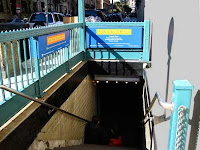Waking up this morning I realized that today was the
last day of class I was a little excited but disappointment hit when I realized
that I would probably never see the people I met in this class again. As I dragged
myself out of bed it was raining and all I could think of is I hope today doesn’t
get washed out and we are not doing too much walking today. Meeting at Penn
Station I felt as if everyone felt the same way relieved that the class was
coming to an end but sad that it is coming to an end.
Today’s class we toured through Little Italy,
Chinatown and the Bowery so I was excited to explore. I love the Bowery the
lower east side. Taking the F train we started our day at the Essex Street
Market. This market began in 1940 with an effort by Mayor Fiorello LaGuardia to
find a new place for merchants to do business. The market offers food for all
tastes such as Latino, Jewish and upscale urbanite (BG, 123).Walking around the market you can see the culture fusion
of the Latino, Korean, Asian and Italian. The little bakery shops engulfed my
nostrils and the aromatic smell took over the front of the market. In the rear
of the market the fresh meat look pink and ready to be cooked nothing like the
frozen meat I find in the regular grocery story.
We entered the house of Bridget and Joseph Moore.
The Moore’s had three daughters; our specific attention was on Agnes Moore the
baby, after moving to the tenement they had to deal with hard living conditions
and shortly after the death of their newborn daughter Agnes due to poisonous milk
given to the poor living in the neighborhood. The main struggles of the people
living in the tenements were to keep their family healthy in such small
confinements. During this time the type of medicine that was available for
struggling immigrants consisted of opium and alcohol. It took a lot of money
and months before a doctor would be able to visit. Next it was time for lunch
my classmates ate at Congee Village authentic Chinese Food; I was not really in
the Chinese mood so I opted to eat somewhere else.
Overall today was a great. I feel very sad that the
class is over but i am excited with what I learned. My eyes have been open to
so many different things and I personally think this would help me be a better-rounded
person, able to discuss art and history if needed.



















